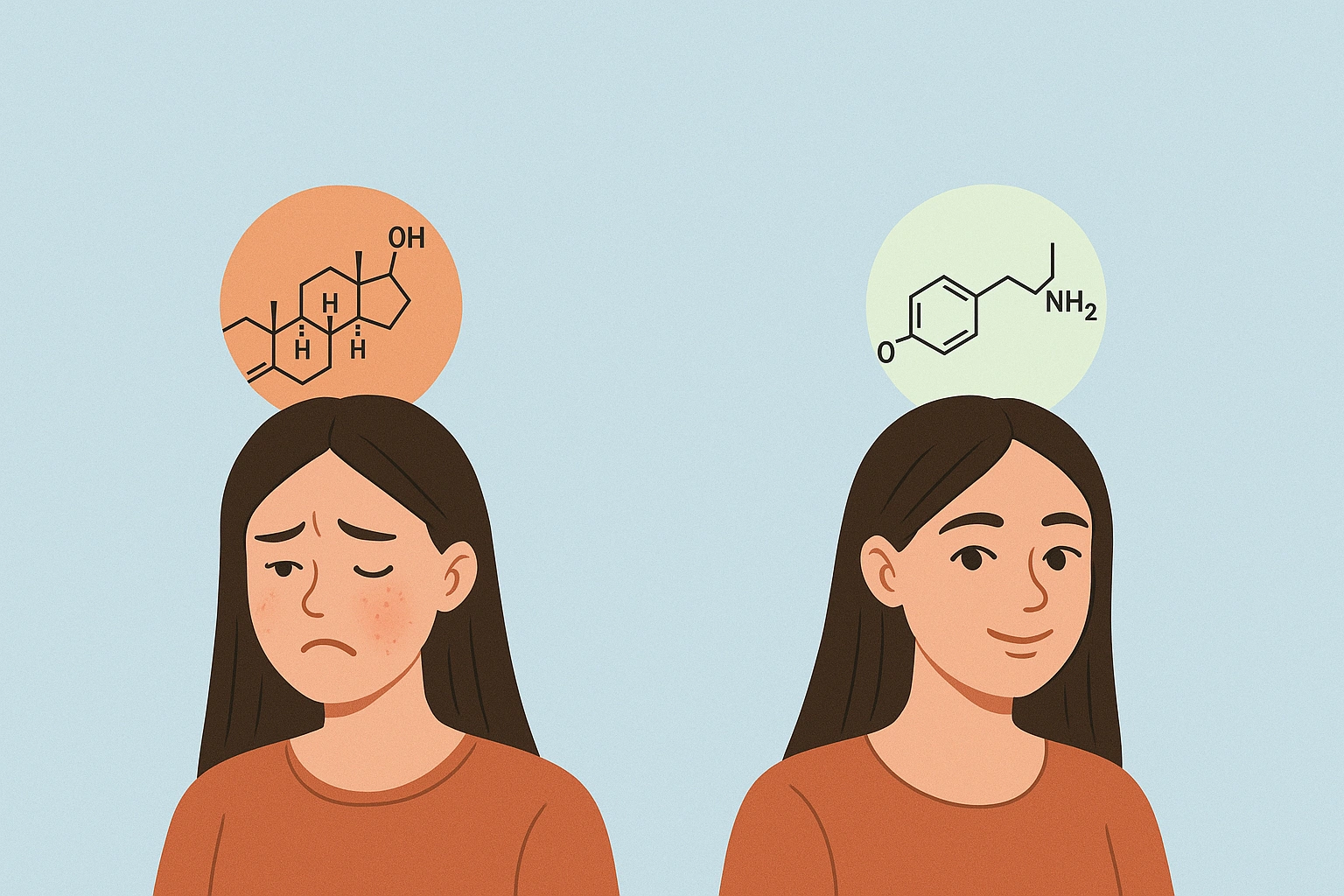Scientific yet human: why emotions leave visible traces on your skin, how hormones affect the barrier, and how to bring calm back to your face without irritation.
We tend to think of our skin as just a protective layer. In reality, it’s the most honest diary of what happens inside us. It instantly reflects anxiety, fatigue, joy, sleepless nights, even a short argument or a good piece of news. All these states have their chemistry — and the skin literally feels it. Glow, dullness, redness, dryness — they’re not only about cosmetics. They’re about mood molecules flowing through your bloodstream.
When Emotions Leave a Trace
When we’re anxious, the body switches into survival mode. The adrenal glands release cortisol — the hormone that saves energy for the brain but takes it away from the skin. Blood vessels constrict, tissue nutrition decreases, and regeneration slows down. If this lasts a day or two, your skin will recover. But if stress becomes your background state, cortisol blocks collagen production, reduces hyaluronic acid synthesis, and thins the lipid barrier.
You can feel it even without having “problem skin”: the tone turns gray, foundation doesn’t sit right, your cream seems useless. That’s when the skin quietly signals that the emotional system is overloaded.
The Biochemistry of Mood in the Mirror
Emotions are not just feelings — they’re chemical reactions that begin in the brain and end in the epidermis:
- Cortisol increases glucose levels, leading to faster aging through protein glycation.
- Adrenaline causes short-term redness, but chronic stress leads to fragile capillaries.
- Serotonin stabilizes microcirculation, reduces microinflammation, and helps cells “communicate calmly.”
- Dopamine influences radiance: when it’s low, the face looks tired even after rest.
- Oxytocin, the hormone of tenderness, activates endorphins in epidermal cells and makes the skin less sensitive.
So when we say “you can see the mood on the face,” we’re talking about a biological truth.
Stressed Skin: The Invisible Microinflammation
Under stress, countless small but continuous reactions happen in the skin. They’re invisible — but they lead to premature aging, loss of tone, and dullness.
- The enzyme elastase activates and breaks down elastin fibers;
- Ceramide levels drop, leaving the barrier “leaky”;
- Cytokines (IL-6, TNF-α) rise, causing microinflammation — a silent process that drains the skin’s energy;
- The microbiome becomes imbalanced, and the skin loses its ability to recover naturally.
This forms a vicious circle: stress → microinflammation → irritation → sensitivity → more stress.
How to Tell When Your Skin Is Emotionally Tired
The signals are subtle but clear:
- dull or grayish tone;
- reactions to your usual cream;
- dryness, tightness, or minor breakouts without reason;
- a sense that your skin “doesn’t want anything.”
Sometimes it’s not an allergy or a product issue. It’s just your skin saying, “please slow down.”
How to Restore Emotional Balance to the Skin
1. Calm yourself — and your skin will follow
Start with the simplest step: slow down.
- 10 minutes without gadgets before bed;
- three deep breaths after cleansing;
- feeling the warmth of your palms while applying cream.
Your skin perceives this as a signal of safety.
Tip: hold the cream in your hands for a few seconds before applying — body temperature activates touch receptors and makes skincare gentler.
2. Choose “smart” cosmetics
Look for formulas that calm neurosensory reactivity:
- Niacinamide (up to 5%) — strengthens the barrier and reduces redness;
- Centella Asiatica (Cica) — soothes pain receptors;
- Peptides — reduce inflammatory cytokines;
- Ceramides NP, AP, EOP — restore the intercellular lipid matrix;
- Prebiotics — balance the microbiome and stabilize sensitivity.
Tip: if your skin feels “tired,” replace your serum with a ceramide cream for 5–7 days — a mini vacation for your barrier.
3. Feed your nervous system
Nutrition affects both mood and skin:
- Omega-3 fatty acids (salmon, walnuts, chia seeds) — reduce microinflammation;
- Magnesium and zinc — regulate dopamine and serotonin levels;
- B vitamins — support nerve function and cell renewal;
- Adaptogens (ashwagandha, rhodiola, holy basil) — help the body respond to stress more calmly.
Tip: a cup of warm water with lemon and a pinch of magnesium salt in the morning helps lower cortisol and improve microcirculation.
4. Touch and massage — nature’s antidepressants
Touch triggers oxytocin release. Even a short self-massage during your evening routine sends the brain a signal: “you’re safe.” It relaxes facial muscles, improves lymph flow, and reconnects you with your body — the foundation of genuine beauty.
Breathing as Skincare
Deep breathing literally changes your skin tone. With every full inhale, your cells get more oxygen, and your blood vessels expand.
Try this simple technique:
- inhale through your nose for 4 counts;
- hold for 7;
- exhale slowly through your mouth for 8.
Tip: do this before applying night cream — improved microcirculation helps actives absorb better.
When Skincare Becomes Therapy
We often see skincare as a duty. But your skin loves when it’s a ritual. Soft light, comfortable temperature, slow movements, pleasant textures — all these create a sensory field that calms your nervous system. Scents matter too: a hint of lavender or vanilla can reduce cortisol by 20% in just 15 minutes.
The Wisdom of Skin
Your skin remembers how you treat it. It responds not only to formulas, but to your presence. It doesn’t understand words — but it recognizes care.
Sometimes the best anti-aging remedy isn’t a new serum, but a quiet moment when you breathe deeply and touch your face with kindness.
The skin is the mirror of the nervous system. When we are calm inside, it shows outside. Mood molecules are not enemies — they’re messengers. And when we learn to listen, our face starts to glow again — without filters, without effort, simply because there’s harmony within.

